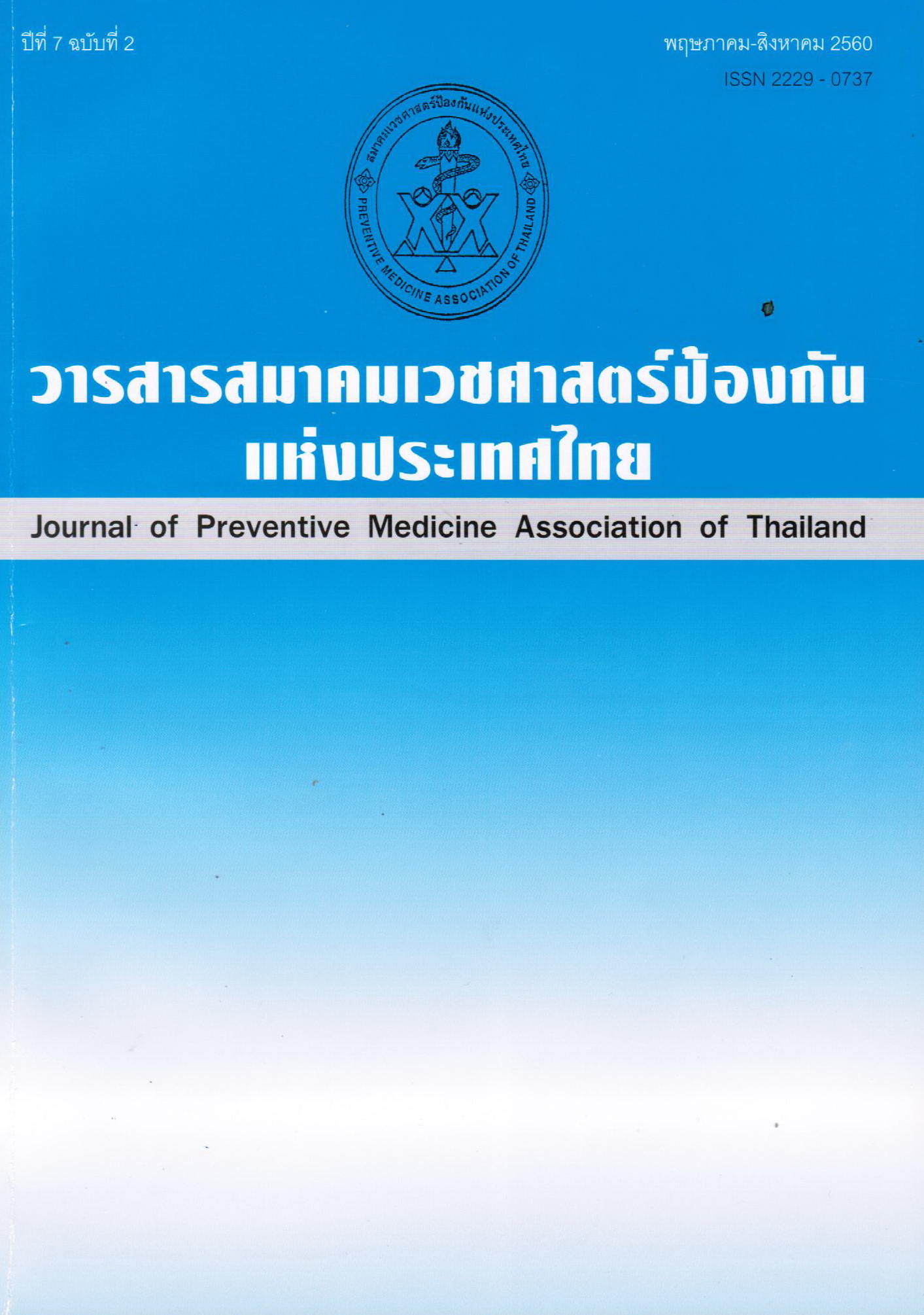Factors Related to Dental Fluorosis in School Aged Children and Water Consumption Behavior. In the Dental Fluorosis Children Family of Tambon Saparn Mai Kaen, Chana District, Songkhla Province
Keywords:
Factors, Relationship, Dental Fluorosis, School aged children, Household water consumption behaviorAbstract
This Cross-Sectional Survey oriented research is to study 1) Dental fluorosis severity level 2) Household water consumption method of dental fluorosis student family from difference fluoride level water sources 3) Factors related to dental fluorosis of primary student in 2015 of Saparn Mai Kaen Community School and Ban Try Kaw School with total 403 persons by a purposive sampling. Tools used for this research are dental fluorosis examination sets which
already certified by inter-examiner calibration with 0.86 Kappa and interviewing of household water consumption getting IOC between 0.67-1.00 including general data analysis which used frequency, average, percentage and Chi-square
Research result found 1) Dental fluorosis students are in suspected dental fluorosis level or beginning level 69.8%, low dental fluorosis level 17.9% and medium/high dental fluorosis level 12.3% 2) Method of household water consumption either drinking, mixing milk, cooking rice/cooking food mainly using low fluoride level water source with 71.7%, 65.0% and 63.2% accordingly and 3) Factors of sex, age and knowledge are not related to dental fluorosis condition of primary students in Saparn Mai Kaen Community School and Ban Try Kaw School.
References
2. Burt BA, Eklund SA. Dental fluorosis. In: Burt BA, Eklund SA, editors. Dentistry, dental practice, and the community. 5th ed. Pennsylvania: Suanders; 1999. p.259-266.
3. Wondwossen F, Astrom AN, Bjorvatn K, Bardsen A. The relationship between dental caries and dental fluorosis in areas with moderate-and high-fluoride drinking water in Ethiopia. [cited 2008 May 7] Available from: URL: http://www.ingentaconnect.com/content/mksg/com/2004/00000032/00000005/art00004
4. Buzalaf MA, Levy SM. Fluoride intake ofอchildren : considerations for dental caries and dental fluorosis. Monogr Oral Sci. 2011;22:1-19.
5. Meenakshi RC, Maheshwari SK. Fluoride in drinking water and its removal. J Hazardous Materials 2006;137(1):456-63.
6. Kimbrough VJ, Henderson K. The consumer’s view of oral health products. In: Kimbrough VJ, Henderson k, editors. Oral Health Education. New Jersey:Pearson Education, Inc; 2006. p.127-39.
7. ชัชวาลย์ จันทรวิจิตร. รายงานการศึกษาความเสี่ยงต่อสุขภาพจากการได้รับฟลูออไรด์. เชียงใหม่:ศูนย์ทันตสาธารณสุขระหว่างประเทศ กรมอนามัย; 2546.
8. สำนักทันตสาธารณสุข กรมอนามัย. รายงานผลการสำรวจสภาวะสุขภาพช่องปากระดับประเทศ ครั้งที่ 7 ประเทศไทย พ.ศ. 2555. กรุงเทพฯ:องค์การสงเคราะห์ทหารผ่านศึก; 2556. หน้า 17-50.
9. Ekstrand, J. Fluoride metabolism. In Fejerskov, In: Ekstrand, J. Burt, A, editors. Fluoride in dentistry. 2nd ed. Copenhagen: Munksgaard; 1996. p.55.
10. ธนิดา โพธิ์ดี, พรสุดา หน่อไชย. การสำรวจปริมาณฟลูออไรด์ในน้ำดื่ม จ.พิษณุโลก. พุทธชินราชเวชสาร 2552;26:2 (พฤษภาคม-สิงหาคม): 142-151.
11. Dean. As Reproduced in “Health Effects of Ingested Fluoride” National Academy of Sciences. 1993:169.
12. Do.LG, Spencer AJ. Risk-benefit balance in the use of fluoride among young children. J Dent Res 2007;86:723-8.
13. Motero M, Rojas-Senchez F, Socorro M, Terres J, Acevedo AM. Dental caries and fluorosis in children consuming water with different fluoride concentrations in Maiquetia, Vargas State, Ven-ezuela. Invest Clin 2007;48:5-19.
14. Ruan JP, Bardsen A, Astrom AN, Huang RZ, Wang ZL, Bjorvatn K. Dental fluorosis in children in areas with fluoride-polluted air, high-fluoride water, and low-fluoride water as well as low-fluoride air: a study of deciduous and permanent teeth in the Shaanxi province. China. Acta Odontol Scand 2007;65(2):65-71.
Downloads
Published
How to Cite
Issue
Section
License
บทความที่ลงพิมพ์ในวารสารเวชศาสตร์ป้องกันแห่งประเทศไทย ถือเป็นผลงานวิชาการ งานวิจัย วิเคราะห์ วิจารณ์ เป็นความเห็นส่วนตัวของผู้นิพนธ์ กองบรรณาธิการไม่จำเป็นต้องเห็นด้วยเสมอไปและผู้นิพนธ์จะต้องรับผิดชอบต่อบทความของตนเอง






